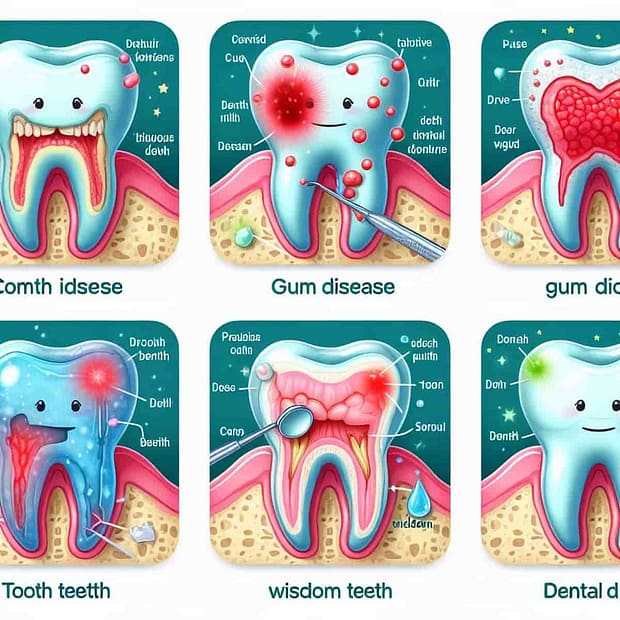Cavities, also known as dental caries, are one of the most common dental problems worldwide, affecting people of all ages. Understanding the causes, recognizing symptoms, and exploring effective treatments are essential for preventing cavities and maintaining optimal oral health. Let’s delve into the details:
Key Takeaways:
- Cavities develop when acids produced by bacteria in plaque erode tooth enamel, leading to decay.
- Symptoms of cavities include tooth sensitivity, pain, visible pits or holes in teeth, and discoloration.
- Treatment for cavities involves removing decayed tooth structure and restoring the tooth with dental fillings, crowns, or other restorative procedures.
Causes of Cavities:
Cavities occur due to a combination of factors, primarily involving the interaction between bacteria, sugars, and tooth enamel. Common causes of cavities include:
- Plaque Buildup: Bacteria in plaque feed on sugars and produce acids that weaken and erode tooth enamel.
- Poor Oral Hygiene: Inadequate brushing and flossing allow plaque to accumulate on teeth, increasing the risk of cavities.
- High Sugar Diet: Consuming sugary foods and beverages provides fuel for bacteria to produce acids that cause decay.
- Acidic Foods and Drinks: Acidic substances can directly erode enamel and make teeth more susceptible to decay.
- Dry Mouth: Reduced saliva flow can lead to dry mouth, increasing the risk of cavities due to decreased protection and remineralization of tooth enamel.
- Deep Tooth Crevices: Deep pits and fissures in teeth provide hiding places for bacteria and make thorough cleaning more challenging.
Symptoms of Cavities:
Symptoms of cavities may vary depending on the severity and location of the decay but commonly include:
- Tooth Sensitivity: Sensitivity to hot, cold, sweet, or acidic foods and beverages.
- Tooth Pain: Persistent or intermittent toothache, especially when biting down or applying pressure.
- Visible Pits or Holes: Visible holes or dark spots on the surface of teeth may indicate advanced decay.
- Tooth Discoloration: White, brown, or black spots on teeth may indicate early signs of decay.
- Localized Swelling: Swelling or tenderness in the gums around the affected tooth in cases of advanced decay or infection.
Treatment of Cavities:
Treatment for cavities aims to remove decayed tooth structure, restore the tooth’s function and appearance, and prevent further decay. Common treatment options include:
- Dental Fillings: Removal of decayed tooth material followed by filling the cavity with materials such as amalgam, composite resin, or glass ionomer cement.
- Dental Crowns: In cases of extensive decay or weakened tooth structure, a dental crown may be placed to cover and protect the tooth.
- Root Canal Therapy: If decay reaches the inner pulp of the tooth, root canal therapy may be necessary to remove infected tissue and restore the tooth’s health.
- Tooth Extraction: In cases of severe decay where the tooth cannot be saved, extraction may be necessary to prevent further complications.
Prevention of Cavities:
Preventing cavities involves adopting good oral hygiene habits and making healthy lifestyle choices to reduce the risk of decay:
- Brush and Floss Regularly: Clean teeth twice daily with fluoride toothpaste and floss daily to remove plaque and food debris.
- Limit Sugary and Acidic Foods: Reduce consumption of sugary and acidic foods and drinks that contribute to decay.
- Use Fluoride Products: Use fluoride toothpaste and mouthwash to strengthen enamel and prevent decay.
- Dental Sealants: Consider dental sealants, especially for children, to protect vulnerable teeth surfaces from decay.
- Regular Dental Check-ups: Schedule dental exams every six months for professional cleanings and early detection of cavities and other dental issues.
In conclusion, cavities are a common yet preventable dental problem that requires prompt treatment to prevent further complications. By understanding the causes, recognizing symptoms, and implementing preventive measures, you can safeguard your teeth against decay and maintain a healthy, radiant smile for years to come. Remember, early detection and treatment of cavities are key to preserving tooth structure and oral health, so don’t hesitate to consult your dentist if you experience any signs or symptoms of decay.










